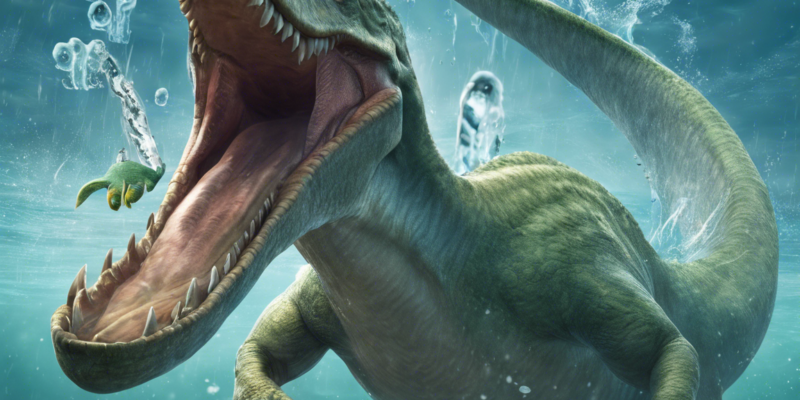Introduction:
When we think of dinosaurs, typically large land-dwelling creatures come to mind. However, the ancient world was also home to a variety of water dinosaurs that roamed the seas and rivers millions of years ago. These magnificent creatures, known as marine reptiles, had a diverse range of shapes, sizes, and adaptations that allowed them to thrive in aquatic environments. In this article, we will explore some of the most fascinating water dinosaurs that once ruled the seas.
1. Plesiosaurs:
Plesiosaurs were a group of prehistoric marine reptiles that lived during the late Triassic to the end of the Cretaceous period. These creatures had long necks, small heads, and streamlined bodies, making them efficient swimmers. Some notable plesiosaurs include Pliosaurus, Elasmosaurus, and Kronosaurus.
2. Mosasaurs:
Mosasaurs were a group of large, predatory marine reptiles that lived during the Late Cretaceous period. These creatures had elongated bodies, powerful jaws, and flippers for locomotion. Some famous mosasaurs include Tylosaurus, Mosasaurus, and Plotosaurus.
3. Ichthyosaurs:
Ichthyosaurs were dolphin-like marine reptiles that lived from the Early Triassic to the late Cretaceous period. These creatures had streamlined bodies, large eyes for deep-sea vision, and tail fins for propulsion. Notable ichthyosaurs include Ichthyosaurus, Ophthalmosaurus, and Stenopterygius.
Adaptations for Aquatic Life:
Water dinosaurs had several adaptations that allowed them to thrive in aquatic environments. Some of these adaptations include:
- Streamlined Bodies: Water dinosaurs had streamlined bodies to reduce drag and increase swimming efficiency.
- Flippers: Many water dinosaurs had flippers instead of legs, which helped them navigate the waters with ease.
- Internal Gills: Some water dinosaurs had internal gills that allowed them to extract oxygen from the water, similar to modern-day fish.
Diet and Behavior:
Water dinosaurs had diverse diets and behaviors, ranging from apex predators to filter feeders. Some were fast-swimming hunters that preyed on fish and other marine reptiles, while others were gentle giants that fed on plankton and small invertebrates.
FAQs (Frequently Asked Questions):
1. Q: What is the difference between dinosaurs and marine reptiles like plesiosaurs and ichthyosaurs?
A: Dinosaurs were land-dwelling reptiles, while marine reptiles like plesiosaurs and ichthyosaurs were adapted to life in the water.
2. Q: Did water dinosaurs give birth to live young or lay eggs like modern reptiles?
A: Most water dinosaurs were thought to lay eggs, similar to modern reptiles.
3. Q: How did water dinosaurs breathe underwater?
A: Water dinosaurs had specialized adaptations such as internal gills or lungs that allowed them to extract oxygen from the water or air.
4. Q: Were water dinosaurs warm-blooded like modern marine mammals or cold-blooded like reptiles?
A: The metabolic rates of water dinosaurs are still debated among scientists, but some evidence suggests they may have been warm-blooded to some extent.
5. Q: Are there any surviving descendants of water dinosaurs today?
A: No, all species of water dinosaurs went extinct millions of years ago, and there are no surviving descendants.
Conclusion:
Water dinosaurs were a diverse group of ancient marine reptiles that roamed the oceans and rivers millions of years ago. From the long-necked plesiosaurs to the dolphin-like ichthyosaurs, these creatures had a range of adaptations that allowed them to thrive in aquatic environments. Studying water dinosaurs gives us a glimpse into the rich and varied biodiversity of the prehistoric world and helps us better understand the evolution of marine life on Earth.

